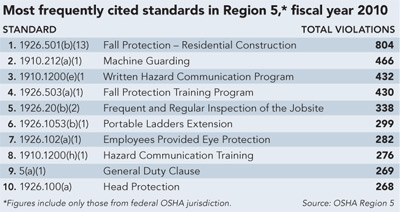Regional Spotlight
 Meeting the challenges
Meeting the challenges
In OSHA Region 5, officials work on partnerships to mitigate hazards
By Kyle W. Morrison, senior associate editor
When officials at OSHA’s Region 5 office began noticing a disturbing trend of increasing fatal grain engulfments, they knew something had to be done.
Farms feature many hazardous operations, and the recent rise in grain engulfments have brought an added distressing element. Several of the more high-profile grain engulfment incidents have involved teen workers.
“We’ve just seen real tragedy,” Regional Administrator Michael Connors said.
To prevent more tragedy, Region 5 – which encompasses Illinois, Indiana, Michigan, Minnesota, Ohio and Wisconsin – initiated a Local Emphasis Program on safe grain handling. Launched last August, the LEP came out shortly before a new study was released confirming an increase in grain engulfments (see “More than a grain of danger,” May 2011, p. 42).
The program and its focus on grain bin dangers eventually were adopted at the national level. Another program that may be taken up at the federal level is Region 5’s primary metals LEP. Industries that handle metals – steel mills, blast furnaces and foundries, among others – had among the highest injury and illness rates in the past 10 years, according to Connors, including overexposure to toxic substances such as carbon monoxide, noise, lead and silica.
Challenges
A major challenge for Region 5 is distance between area offices. In addition to several big cities, including Chicago, Cincinnati, Detroit, Minneapolis and Milwaukee, Region 5 is home to many large rural areas. A single metropolitan area may have one or even two offices, but some large parts of the region may only have one. It sometimes can take up to five hours to travel to a location for a consultation or inspection, according to Nick Walters, director of the agency’s area office in Peoria, IL.
To ease the burden, Walters said area offices tend to group together inspections or outreach efforts to accomplish as much as possible in a single trip.
The variety of industries in the region also can be an issue. One day, an inspector may be looking into industrial hygiene at a foundry, and the next at bloodborne pathogens at a dental office. “They don’t have to be an expert in every industry, but they do have to recognize and evaluate hazards,” Connors said.
OSHA employees in Region 5 are able to stay more up-to-date on various occupational hazards because of the OSHA Training Institute, located in a northwest suburb of Chicago. In addition to being located within driving distance from essentially anywhere in the region, the institute allows OSHA employees in the area to attend additional training courses when last-minute openings occur, Connors said.
Partnerships
Like some other OSHA regions, Region 5 has been working to bridge the safety gap with non-English-speaking workers. Region 5 has staff that covers 10 foreign languages, including Russian, Chinese and Spanish. But language is not the only barrier the region faces.
“There’s the reluctance of many immigrant workers to work with the government, for whatever reason,” Connors said. “We need to put a human face on OSHA and interact with the community groups so we can build up that trust.”
Region 5 has developed several successful partnerships. About 10 years ago, the region joined up with the power line transmission industry to train apprentices in an effort to reduce injuries, illnesses and fatalities. Region 5 also has reached out to community organizations and religious groups.
In addition to stepping up enforcement to prevent grain engulfment, Connors said a coalition was formed with family members, unions and a grain handling association to initiate safety training. Another group is working on outreach efforts for dairy farms, particularly those with migrant camps attached.
“We’re spreading the word and creating that awareness,” Connors said.

Post a comment to this article
Safety+Health welcomes comments that promote respectful dialogue. Please stay on topic. Comments that contain personal attacks, profanity or abusive language – or those aggressively promoting products or services – will be removed. We reserve the right to determine which comments violate our comment policy. (Anonymous comments are welcome; merely skip the “name” field in the comment box. An email address is required but will not be included with your comment.)

